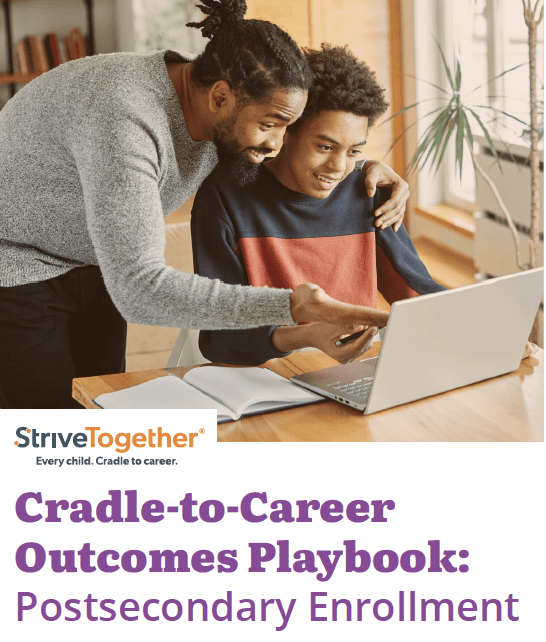OUTCOMES PLAYBOOK
Postsecondary
Enrollment

Communities across the country recognize that supporting students beyond high school is critical to future success — for young people and for the long-term health of the economy. All students must have access to meaningful postsecondary options in today’s rapidly changing world. With 70% of U.S. jobs expected to require education or training beyond high school by 2031, boosting postsecondary enrollment is a powerful lever for improving individual opportunity and community well-being (CEW, 2021). Higher enrollment and completion rates are associated with lower unemployment, increased civic engagement, stronger tax bases and better health outcomes.
The StriveTogether Outcomes Playbook: Postsecondary Enrollment is a comprehensive guide to the latest research and best practices for this outcome, made possible by support from the Gates Foundation. Communities can use the playbook to identify local needs, prioritize areas for collective action and improve strategies.
What Does Postsecondary Enrollment Mean?
Postsecondary enrollment refers to the pathway students take after high school that leads to further education, training or employment. This includes enrollment in two-year and four-year colleges and universities, participation in career and technical education (CTE) programs that result in industry-recognized certifications, registered apprenticeships, entry into skilled trades or military service. In today’s economy, postsecondary enrollment encompasses pathways that are explicitly aligned with earning a degree, credential or skill set of value that leads to a career offering at least a living wage. It is no longer sufficient for students to graduate high school alone; success now depends on gaining the postsecondary preparation necessary to access economic mobility and long-term stability.
How to Use the Postsecondary Enrollment Playbook
Mathematica’s Education-to-Workforce Framework is the inspiration behind the playbook’s organization and content. The playbook provides research-based guidance to help community leaders:
- Identify priorities
- Track key indicators to measure community-level progress
- Design strategies with stakeholders
- Build collective support for investments in postsecondary enrollment
How the Postsecondary Enrollment Playbook Complements Mathematica’s Education-to-Workforce Framework
The playbook supplements the Education-to-Workforce Framework by incorporating research on early childhood reading development, strategies for improving high school graduation rates, the need for high-quality, trained representative educators and more. 81% of the indicators, practices and policies (47 out of 58 total) included in the Postsecondary Enrollment Playbook come from the Education-to-Workforce Framework.

